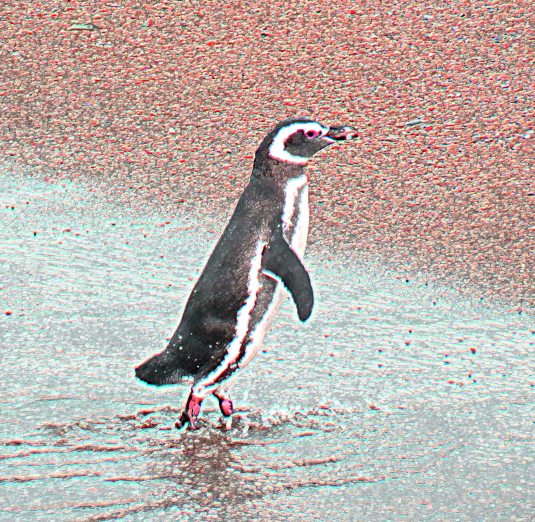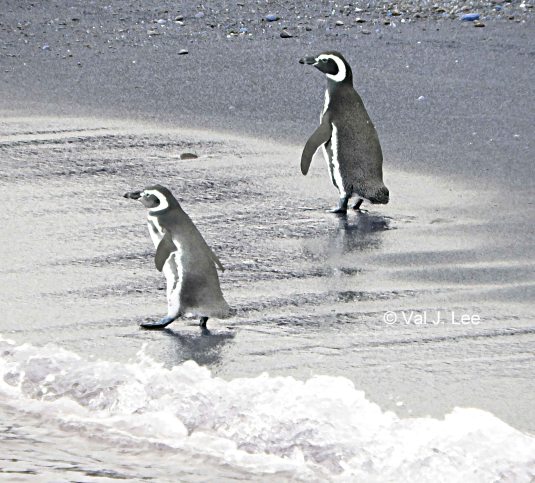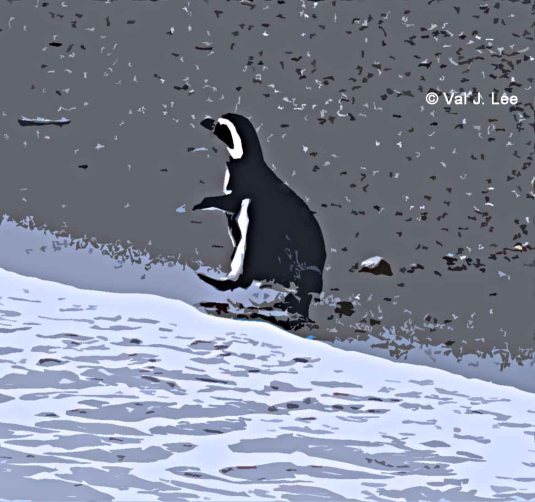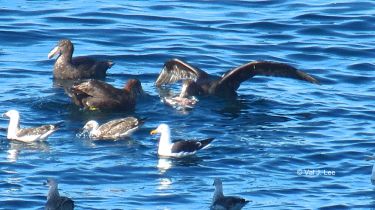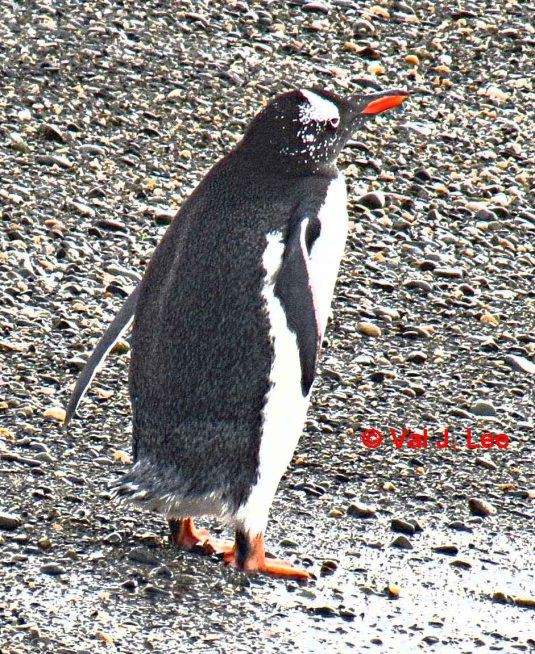- Penguins (Juvenile)
Seeing the Penguins of Patagonia in South America was a dream come true. The LORD God was completely gracious to allow my husband, Al, and I, this blessed experience. We departed from Ushuaia, Argentina, in an enclosed, water tour craft to see the wonders of the Beagle Channel, within the Straights of Magellan. This is called the “End of the World.” The Beagle Channel, or Beagle Canal, is 150 miles long, encompassing both Argentina and Chile. It runs from the Atlantic Ocean to the Pacific Ocean, east to west or visa versa. In this area of the end of the world, you round the cape (Cape Horn) by ship,
And later view the Andes Mountains in the Strait of Magellan.
These little Penguin guys are just all too cute.
Video:
Jesus Christ certainly blessed mankind when He created these multifunctional bird/fish creatures. He gave us countless animals who own captivating attributes that thrill our hearts.
It was such a joy to have a Penguin jumping in and out of the water next to our boat like a dolphin for a short period, as we traveled the Beagle Channel.
Magellanic is strictly a South American Penguin, breeding in coastal Argentina, Chile and the Falkland Islands. A few do migrate to Brazil. The Magellanic Penguin breed was named after the Portuguese explorer, Ferdinand Magellan who first spotted this bird in 1520. Of course, the Strait of Magellan was named after him as well.
These bird/fish travel in flocks when merging with ocean waters when on the hunt. They swim like fish as perfect underwater divers who love to catch and eat their fill of petite sea-creatures in God’s life-springing blue waters that provide them with cuttlefish, squid, krill and crustaceans. Great things to munch on. Bon-appetit.
There are 12 types of Penguins. They all ingest salt water with their prey food, their salt excreting glands cleanses the salt from their bodies. No one who has common sense, can absolutely declare that absolutely nothing created these magnificently crafted creatures. Evolution is the god of the foolish. As the Bible states, the fool says in his heart there is no God. (Psalm 14:1)
The Magellanic swimming birds are 24 to 30 inches in length and can weigh up to 14 pounds—weight can vary. The weight of both parents drops significantly during the feeding of their young.
Magellanic Penguins are migratory, some birds traveling as far north as Peru and Brazil to winter.
Parents feed their chicks by regurgitating partially digested food; this is the way of all Penguins. As we note often in wildlife, the males are larger than the females.
You can view from the photos the fact the adults have black backs and white abdomens. They possess a black stripe that runs from their beak upward. It then travels down the back on their heads, and then, wraps like a necklace about their throat.
Chicks and juveniles display grey-blue backs, with a more faded grey-blue color upon their chest. (See photo above)
Magellanic Penguins can live up to 25 years in the wild; however, as long as 30 years in captivity. God is gracious with the years of life He grants them.
Akin to other Penguin species, the Magellanic, has very rigid wings, implemented to cruise under water, as if in flight. They also own the best manufactured eyes for hunting in water and living on land … an amazingly crafted bird for land and sea; though not for air flight as they are a non-soaring bird.
Magellanic Penguins are faithful for life in union. They have been utilized for illustration, to explain how people should be faithful in marriage for life, including one European, secular news source: “Nature’s most loyal lovers: Magellanic Penguins always return to same mate after solo journeys totaling 200,000 miles.” One unique couple remained faithful for 16 years. This was remarkable as Penguins can easily perish due to the many hazards they encounter. Many Penguins have to locate new mates as many do not survive the year.
Penguins are equipped by God with locating apparatus within. Among hundreds of thousands of birds, a male or female can home in on their special someone through their one of a kind, distinct call. And parents and their young can locate each other through voice recognition. Penguins can appear alike to us, but they recognize their differences. It is slightly similar to a racial group all appearing the same to a person of a different nationality, though they well distinguish themselves among themselves. Just as no two snowflakes are alike, no animal is totally like another. God is not known to make copycats in His animal kingdom and human kingdom.
We all know there will never be another Abraham Lincoln nor Bobbie the Wonder Dog. In 1923, Bobbie traveled with his family from Silverton, Oregon to Indiana for the family’s vacation. He was a two year-old Scotch Collie/English Shepherd mix. Sadly, during the vacation, Bobbie was separated from his owners. The family engaged in an exhaustive search. Unfortunately, they could not locate their beloved canine. They were forced to return to Oregon. Six months later, February of 1924, Bobbie appeared on the doorstep of his home in Silverton. He was extremely thin, dirty, and weak. His feet were worn to the bone. Bobbie had walked 2,551 miles (4,105 km) across the United States to return home. God was gracious to this family and dog.
Animals and mankind are handcrafted by God Almighty. God says of man that he is fearfully and wonderfully created from the time of conception in Psalm 139, within the Bible. Man is different from animals as man has an eternal soul. Animals do not. This is why Christ came and died for you that you might be saved from your sins and live eternally in heaven. Please click here to learn of God’s personal love for you: letter-to-bird-enthusiast
When Penguins are attracted to each other for a lifetime commitment, they will woo each other by performing a display stretch with their necks, point their beaks skywards, while spreading their wings and making a braying (donkey-like) noise. This is performed repetitively, over periods of an hour or more. Magellanic Penguins also perform allopreening (preening or grooming each other with their beaks). This serves a dual purpose, it reinforces bonds between Penguins and removes parasites; though the later is not romantic at all.
An Attached Penguin male will reclaim his nesting burrow (They dig holes with a mound at the top) from the previous year and await to reconnect with his lifetime mate—the mother of all their chicks.
The Penguins nest in communities, being most social.
Their nests are constructed under bushes if not burrowed. Two eggs are generally laid. God created them to lay the perfect eggs, which do not fall on ledges, they spin because they own one narrow end and balance themselves. The incubation period is 39–42 days. Mom and Dad take turns guarding the nest. While one takes the sentry position, the other sets out to sea for food. Eggs and young chicks can fall victim to various types of Seagulls so parents must always be on guard duty.
After hatching, Mom and Dad share in their task of chick care. Chicks are fed daily, with one of their parents leaving the colony in early morning and returning with food later the same day. Fledging (departing the nest) occurs at 9 to 17 weeks of age. The offspring are raised through adulthood.
Magellanic Penguins, at the Patagonian coastal areas, are classified as a threatened species due to the vulnerability of large breeding colonies to oil tanker discharges. Sea lions and Giant Petrels also prey on the young.
Additionally, heavy rain can lead to the flooding of burrows and killing of chicks, which have yet to develop waterproof plumage. And burrows can collapse when trampled on by guanacos (family of Lamas) or cattle. These aves also can be plagued by Penguin fleas, though this is not life-threatening.
Magellanic Penguins are considered relatively aggressive and can inflict a strong bite if handled. Although they can be approached, they are wary of unfamiliar people.
Guanay Cormorants were everywhere. They appear to be Penguins, when amongst the Penguins. You have to peer and observe to see the difference. (See photo above)
The Gentoo Penguins live amongst the Magellanic as if they were of the same family of Penguin. The Gentoo Penguin is easily recognized by the wide white stripe extending like a hat bonnet across the top of its head and its red bill. Also they display pale-pink webbed feet, and a fairly long tail—the most prominent tail of all Penguins.
Nests for their offspring consist of a roughly, circular pile of stones and can be on the large side. The stones are jealously guarded! Their acquired ownership can be the subject of noisy disputes between individual Penguins. The stones are prized by the female Gentoos. A male Penguin knows he can strand in good favor of a female by offering her a nice stone. Needless to say, a great deal of theft takes place during nesting season. They lay two eggs and both parents care for the young, same as the Magellanic.
As the Gentoo Penguin waddles along on land, its extended tail sweeps from side to side like a broom. This visualization explains their scientific name “Pygoscelis,” which translates—”rump-tailed.”
The Gentoo Penguin can reach speeds up to 22 miles per hour, swimming under water. (The Magellanic can reach speeds of 15 mph.) They are not tortoises when it comes to motoring through the oceans. Top Olympian swimmers can swim in the ocean at 2 miles per hour.
Gentoos are also jumping Penguins. God masterfully created them to jump and run quickly over the rocks where they live. They can even outrun people.
Side note: Sailors discovered Penguin eggs could be kept 6 months when rubbed with oil and placed in sand for a future food source.
*Info gratefully gathered from various web sources.
Please click on blue to view my South American slide video: South America – Beautiful Scenery Slide Show
Please click on blue to view my Sea Lion video: Sea Lions at the end of the world in Ushuaia
*Advertisements are not placed by me, they are placed on the post by Word Press. I apologize for anything inappropriate.



